Function & Layout of Larder kitchen
The word garde manger is a French word means Keeper of the food. Garde manger means larder in English. The word larder came from the word LARD meaning pork (pig) fat. The name was given to the place in kitchen used as the cold storage for perishable items like meat, fish, poultry, eggs and milk. It is a department set aside for the storage of both raw and cooked and where food stuffs such as meat fish poultry and game are prepared and made ready for cooking. This department is also known as “Gar de Manger” meaning “station of eatery”
A larder is a cool area for storing food prior to use. Originally, it was where raw meat was larded—covered in fat—to be preserved. By the eighteenth century, the term had expanded. Its is a dept of kitchen concerned with storage of all perishable foods both raw & cooked and is also used for processing, all cold preparations like butchery, preparing sauces, salads, salad dressings, sandwiches, canapes and cold meats etc. the head chef of this dept is known as larder chef or chef garde manger.
Larder kitchen is a cool, well-ventilated area where cold dishes (such as salads, hors d’œuvres, appetizers, canapés, pâtés and terrines) are prepared and other foods are stored under refrigeration. The person in charge of this area is known as the chef garde manger. Preserved food such as Hams, Sausages, bacon, cheese etc were held in this area.
Larder kitchen is mainly involved in procuring of meat directly from the supplier and after processing it provides meat and fish to rest of the kitchen. Larder kitchen is generally in the basement, but the lader should be in the center of all the restaurant kitchen and closer to receiving area!
Modern Meanings
In the modern culinary arts, the term garde manger can refer to the chef who oversees cold food production. Similarly, garde manger can also refer to the specific area of the kitchen where cold food production takes place.
Classical Meaning
In the classical culinary arts, garde manger refers to a category of foods produced in the cold kitchen as well as the broad array of techniques used for preparing these foods. Some examples:
- Smoked and cured foods
- Salads and salad dressings
- Sausages, pâtés, and terrines
- Cheese-making
- Pickled foods and condiments
- Cold sauces and soups
Because the tradition of garde manger dates to an age before refrigeration, it encompasses many classical techniques for preparing and preserving foods, such as ballotines and galantines (which are essentially elaborate stuffed chicken leg preparations and, broadly speaking, a form of sausage).
Even before refrigeration, kitchens generally had one area that was constructed to maintain cool temperatures, usually a cellar of some kind. This was particularly true for large ones where the chefs who cooked for royalty and the nobility performed their duties,
Garde Manger Basics
The garde manger chef, also known as the pantry chef, is the person who plans, prepares, and presents artistic, or creative, cold foods. These foods include salads and salad dressings, cold hors d’oeuvres, fancy sandwiches, canapes, and cold platters.
The garde manger chef plans dishes using many fresh ingredients, including vegetables, fruits, prepared meats, fish, seafood, breads, and cheeses. Simple ingredients are used to create and artistically present horsd’oeuvres, salads, canapes, fancy sandwiches, garnishes for all types of dishes, and fruit, cheese, meat, relish, and combination trays. In addition, he or she may also prepare cold sauces, some hot hors d’oeuvres and hot appetizers, and artistic garnishes and ice sculptures.
Garde manger chefs also make forcemeats as part of their work. Forcemeat is a mixture of ground, raw meat or seafood that is emulsified with fat. The mixture can be ground fine or coarse. Forcemeats are used in many different items from charcuterie, such as sausages and pates.
Some large restaurants or hotels may ask the garde manger chef to create table arrangements and edible center pieces for buffets. These center pieces may be made from materials such as ice, cheese, butter, fruit, or salt dough.
The garde manger chef manages the garde manger department in restaurants, large hotels, and many catering operations. He or she manages a team of people called a garde manger brigade. Each member of the garde manger brigade specializes in a particular type of cold food preparation. Although it is called a brigade, the garde manger brigade has a much looser structure than the traditional kitchen brigade-
- The Boucher, who butchers all meats and poultry.
- The Hors d’Oeuvrier, who makes all hors d’oeuvres.
- The Charcutier, who makes sausage and smoked items, such as meats, cheeses, and nuts.
- Prepare food garnishes:-
Many garnishes are created in the garde manger work station. The word garnish comes from the French word garnir, meaning to decorate or furnish. In the A garnish should complement the flavors and textures of the meal. Mushrooms, cucumbers, scallions, pickles, radishes, and lemons are good examples of garnishes. A quenelle, or a puree of chopped food formed into shapes, can also be used.
Garde Manger History
The term garde manger means keeping to eat. Wealthy families in France in the 1700s had a household steward who would keep foods in the family’s cold storeroom. This person was very important because much of the food kept in the cold room was butchered, pickled, salted, cured, or smoked during the fall season and stored for months.
The steward had to keep the food safe and portion it out to last for the winter season. During the Middle Ages, many of the food preparation techniques that were done by the garde manger chefs were performed and taught by guilds. Charcutèrie was the name of a guild that prepared and sold cooked items made from pigs. When the guild system was abolished during the French Revolution, garde manger chefs performed the tasks of the charcutiers and went to work in restaurants.
Butchers originally worked under the garde manger station. But as the need for cuts of meat increased, more space was needed for butchering. Eventually, the butcher worked out of a separate butchery shop. The work of the garde manger chef requires a high level of skill and artistry. However, in some modern restaurants, the term garde manger is used to identify the salad station, and the position is often filled by an entry-level cook.
For these functions to be carried out, it is essential that:
- The larder be separated from the kitchen and located in a cool place. At the same time, it must be close to the kitchen to avoid undue running about between two departments which are closely interrelated.
- It should be light, airy and well established and sufficiently spacious to allow the staff to carry out their duties in a clean and efficient manner. It must also be able to store prepared foods and buffets in a cool and hygienic manner.
- It should be equipped with the necessary fitting, machinery and tools. In accordance with the volume and/or quality of the trade of the catering establishment in which it is situated.
BREAKDOWN OF LARDER KITCHEN WORK
- Taking the above into consideration, it naturally follows that the work is broken down into various fields such as Hors d’oeuvre, Salads, Butchery, Poultry, Cold Buffet etc, and in effect, in large busy establishments each of these functions or duties are carried out by one or more men or sometimes women, who specialize in the work of that particular sub-department.
- More frequently, these various duties are allocated by the Chef Grade Manager, who is in overall charge of the department, to commis or assistant chefs, and they are known as Commis Grade-Manager, whatever duties they are assigned to. The smaller the volume of trade the fewer commis required, and so on. In many establishments the Chef Grade-Manager is single handed and carries out all the various functions himself.
- It should be mentioned at this stage that often quality rather than quantity, of trade is the determining factor in deciding the number of staff required in the Grade-Manager, or for that matter in the kitchen as a whole.
EQUIPMENTS FOUND IN THE LARDER KITCHEN
Heavy Duty equipment’s-
- Refrigeration equipment including refrigerators, walk-ins, reach-in, pull outs, deep freezers, bottle coolers, ice machines, coolers and chillers.
- Food Processors with attachments for grinding, pureeing, kneading, mixing, Buffalo choppers, bone saws
- Gas range, boilers, heaters (if required)
- Weighing scales – Electronic and manual
- Steel tables, cupboards, storage racks and sinks
Light equipment’s
Mixers, juicers, Butchers block, Storage bins and shelves, Slicers, Blow torch, Pots, pans, stockpots, larder tools such as serving spoons and ladles, sieves , Colanders , Conical strainers and Chinois, heat Presses , Pie moulds, whisks, egg slices, steel basins and graters
Miscellaneous utensils & equipment’s:
- Frying and flat spoons.
- Assorted knives (Butchers Boning knives, butcher’s steak or cutting knives, Butchers saw, Butchers saw, Butcher’s choppers and cleavers, Butchers chopping Knives, Cook’s filleting Knives, Butchers chopper etc.
- Piping bags and assorted nozzles, Peelers, fancy cutters, mandolin slicer, Wooden spoons and mushrooms,
- Steak hammers (for flattening cuts of meat)
- Larding and trussing needles and pins (for larding and trussing joints of meat and poultry)
- Lemon zesters & decorators (for scraping and channeling lemon peel) – decorating knives and vegetable scoops (for shaping vegetables & potatoes)
- Skewers – butchers hooks (for hanging joints)
- Brining syringe (for pumping brine solution into joints)
- Brinometer (for measuring density of brine solution) assorted thermometers – Assorted trays for storage of food.
Layout of Larder/Garde manger Kitchen-
Planning the layout for a garde manger department can be a complex task. Garde in French means ‘to keep’ and manger means ‘to eat’, so garde manger literally means ‘kept cold to be eaten’. This kitchen is called cold kitchen as foods such as sandwiches, salads, juices are prepared and served out from this kitchen.
This kitchen is always a part of the main kitchen as it not only serves a la carte and banquet, but is also responsible for room amenities, welcome drink to the guests and many other support roles for other kitchens.
Unlike other departments that can depend on a basic menu and basic workload, the Garde Manger department is unique in its operation. On a daily basis the Garde Manger department may handle its own butchery, its own bakery, and its own sauce making, its own frying, smoking of fish and cold meats, all the decorating including tallow and ice sculpture, Plus a complete line on charcuterie products such as galantines and pates.
Picture gallery of Larder/Garde manger Kitchens Layout in Hotels

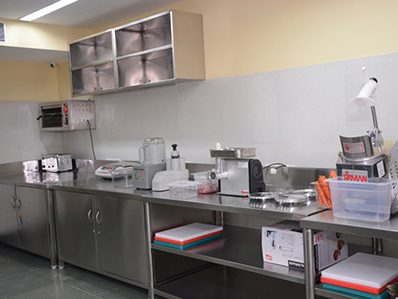
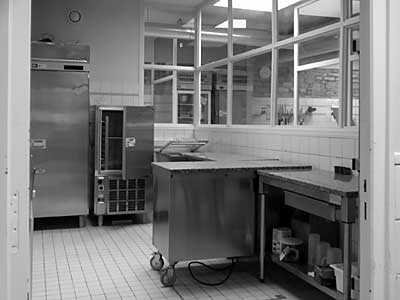

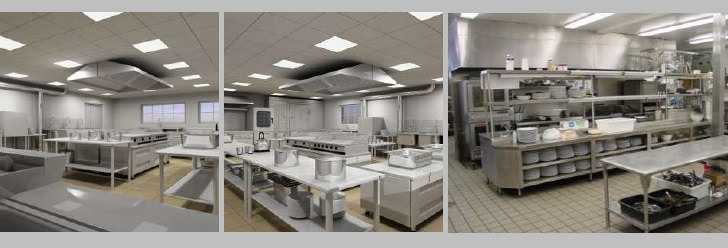


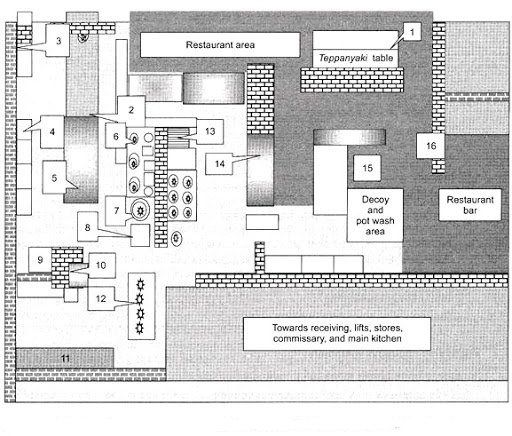
Layout of Butchery Kitchen:
Butchery is the biggest money holding centre of the hotel operations; though it does not make money directly, it is indirectly responsible for maintaining the food cost. This section of the kitchen stores and processes most expensive meats which are both local and imported.
Hence, a well-planned butchery operation is a must for a profitable food business. Butchery, in various hotels are part of food stores; as they process all the meats and store them for usage in the kitchen against food requisitions.
Separate walk-ins and separate workstations are provided for separate meats as there could be chances of food contamination. Below picture shows the layout of a butchery.
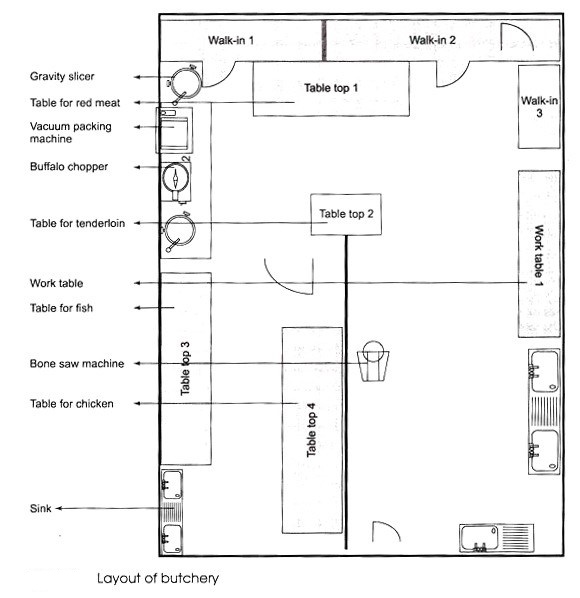
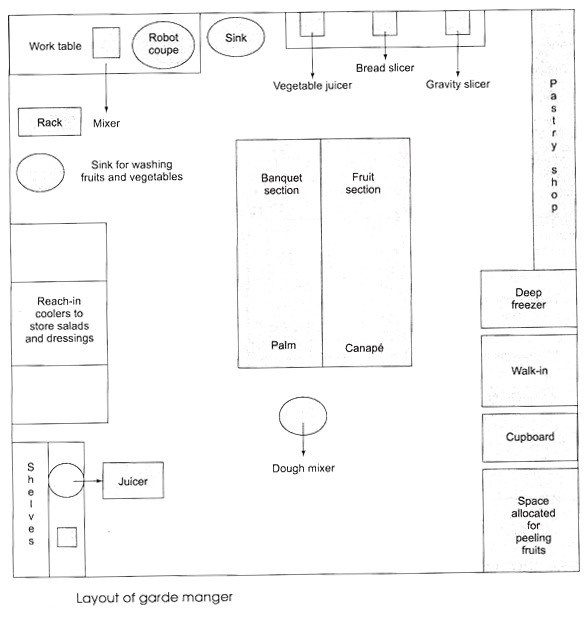
CONTROLOF LARDER KITCHEN-
If the larder is to be run efficiently and economically, it is essential that the chef Garde Manger should exercises strictest possible control over the food stuffs received and stored in the department.
This will involve:
- Checking the quantity and quality of all goods delivered to the larder.
- Ensuring that all food stuffs are stored at the right temperature and that they can be easily checked.
- That the food is protected from contamination.
That Portion Control is rigidly carried out e.g., a given piece of meat, fish and vegetable should always Produce required portions of steaks, fillets, salads or Hors d’oeuvre.
That stocks are regularly turned over. - That food is not overstocked.
- A simply daily stock sheet by each sub department is maintained
- Every Possible effort must be taken to discourage Pilferage.
DUTIES & RESPONSIBILITY OF GARDEMANGER CHEF
- Checking the quality and quantity of all food received in the department.
- Ensuring that all food stuff is stored at the right temperature and that they can easily be Checked
- That portion control is ensured.
- That stock is regularly turned over.
- That food is not over stocked.
- A simple daily stock sheet to be maintained by each sub department.
- Every possible effort is made to ensure the highest standard of hygiene.
- Pilferage (theft or burglary) is discouraged and controlled.
- He is responsible to the Executive chef for the smooth running and operation of his department.
- He is also responsible for co ordination between his staff and has to make sure that they have understood the work required from them and the production schedule, either daily or weekly.
- Training is another important function he has to carry out. The work of the larder is of a highly skilled nature and involves a lot of expensive ingredients, procedures and equipment It is therefore imperative that the staff is well trained.
- The larder Chef is also responsible for staff scheduling and duty rotas.
- He is also required to co-ordinate with the other departments like the kitchen and the bakery. A lot of pre preparation is done in the larder for the other departments and satellite kitchens. Their requirements must be made available well in advance.
- He also has to maintain registers to record the receipts and dispatch of the foodstuff.
- He is also responsible for maintaining hygiene and sanitation standards in the department. A lot of the foodstuff being processed here is in the raw sate and susceptible to contamination and possible food poisoning.
LARDER WORK
The larder or Garde Manger is a department set aside for the storage of perishable food, both raw and cooked and were food stuffs such as meat fish poultry and game are prepared and made ready for cooking.
In this department all cold food items found on the menu such as Hors d’oeuvre cold fish or meat dishes, cold sauces, salad dressings are prepared and dressed. One particular special duty of this department is the preparation and presentation of all types of cold buffet, which are nowadays a feature of so many functions.
For these functions to be carried out, it is essential that:-
- The larder be separated from the kitchen and located in a cool place. At the same time, it must be close to the kitchen to avoid undue running about between two departments which are closely interrelated.
- It should be light, airy and well established and sufficiently spacious to allow the staff to carry out their duties in a clean and efficient manner. It must also be able to store prepared foods and buffets in a cool and hygienic manner.
- It should be equipped with the necessary fitting, machinery and tools. In accordance with the volume and/or quality of the trade of the catering establishment in which it is situated.
LARDER WORK CONTROL
If the larder is to be run effectively, efficiently and economically, it is essential that the Chef Garde Manger exercise strict control over the foodstuff received and stored in the department.
This will involve:
- Checking the quality and quantity of all food received in the department.
- Ensuring that all food stuff is stored at the right temperature and that they can easily be checked.
- That the food is protected from contamination by vermin.
- That portion control is ensured.
- That stock is regularly turned over.
- That food is not over stocked.
- A simple daily stock sheet to be maintained by each sub department.
- Every possible effort is made to ensure the highest standard of hygiene.
- Pilferage is discouraged and controlled.
LARDER WORK STOCK SHEET
The stock and order sheet should be as simple and easy to keep up to data as possible. A complicated stock sheet requiring too much writing will defect the whole purpose as it will be neglected during busy rush periods, the very time it is needed most. For some sub departments, devising an easy and simple system is reasonably easy. In some cases it is not so easy for example; also keeping of the stock of food sent in and returned by the cold buffet can be complicated and time wasting if one is to measure every ounce or inch. Therefore it is necessary to accept some rule of thumb providing it is well supervised. An experienced chef Garde Manger should be able to tell at a glance the weight, or number of Portion of a given joint or cold dish. The butchery department also presents some Problems and the stock sheet for this department needs careful consideration. Each establishment will devise its own system taking into account its own problems.
| Department | Day and date | ||||
| Item | Unit | Stock | Unit Price | Cost | Order |
| Tomatoes | kg(lb) | 2 | 12 | ||
| Sardines Fish | Tins | 4 | 8 | ||
| Eggs | doz | 11/2 | 4 | ||
| Oil | 1.(gal) | 1/2 | 1 | ||
| Vinegar | 1.(qt) | 1 | 2 | ||
YIELD TESTING
Yield % is important in the area of recipe costing. This is true because a recipe cost must take into account the difference in price of products in their AP or EP state (AP refers to food products as the operator receives them; EP refers to food products as the guest receives them)
In order to determine actual recipe costs, it may sometimes be necessary to conduct a yield test to determine actual EP ingredient costs. A yield test is a procedure used for computing your actual costs on a product that will experience weight or volume loss in preparation.
Total Yield % = Remaining Weight x 100
Original Weight
Waste % is the percentage of product lost due to cooking, trimming, portioning, or cleaning.
COMMON CULINARY TERMS USED IN THE LARDER & LARDER CONTROL
Aging: Holding meats in coolers under controlled conditions to allow natural tenderizing to take place.
AP required: As-purchased amount necessary to yield the desired EP weight. AP required is computed as EP required divided by yield percentage.
Antipasto: Italian Hors d’oeuvre
Beginning inventory: The dollar value of all products on hand at the beginning of the accounting period. This amount is determined by completing a physical inventory.
Bin card: An index card with both additions to and deletions from inventory of a given product. To facilitate its use, the card is usually affixed to the shelf that holds the given item. Used in a perpetual inventory system.
Canapé: An hors d’oeuvre consisting of a small piece of bread or toast, often cut in decorative shape, garnished with savoury spread or topping.
Carpaccio: Very thin slices of meat or fish, served raw.
Carryover: A menu item prepared for sale during a meal period but carried over for use in a different meal period.
Casing: A synthetic or natural membrane used to enclose sausage forcemeat.
Caul: A fatty membrane that covers the stomach of a pig; used for wrapping meats for cooking and for lining terrines.
Chitterlings: Pork intestines.
Coulis: A vegetable or fruit puree, used as a sauce.
Crepinette: A sausage patty wrapped in caul.
Crudités: A raw vegetable served as a relish.
Daily inventory sheet: A form that lists the items in storage, the unit of purchase, and the par value. It also contains the following columns: on hand, special order, and order amount.
Edible portion (EP): This term refers to the weight or count of a product after it has been trimmed, cooked, and portioned.
Ending inventory: The dollar value of all products on hand at the end of the accounting period. This amount is determined by completing a physical inventory.
First-in, first-out (FIFO): Term used to describe a method of storage in which the operator intends to sell his or her oldest product before selling the most recently delivered product.
Forcemeat: A mixture of chopped or ground meat and other ingredients used for pates, sausages and other preparations.
Garniture: Garnish; the act or process of garnishing.
Inventory turnover: The number of times the total value of inventory has been purchased and replaced in an accounting period.
Lard: The rendered fat of hogs; to insert strips of fat into meats low in marbling.
Last-in, first-out (LIFO): Term used to describe a method of storage in which the operator intends to sell his or her most recently delivered product before selling the older product.
Par level: A system of determining the purchase point by using management-established minimum and maximum allowable inventory levels for a given inventory item.
Requisition: When a food or beverage product is requested from storage by an employee for use in an operation.
Shelf life: The period of time an ingredient or menu item maintains its freshness, flavor, and quality.
Tripe: The muscular stomach lining of beef or other meat animals.
Waste percentage: This formula is defined as product loss divided by AP weight and refers to product lost in the preparation process.
Working stock: The quantity of goods from inventory reasonably expected to be used between deliveries.
Yield percentage: This formula is defined as 1 minus waste percentage and refers to the amount of product available for use by the operator after all preparation-related losses have been taken into account.
Yield test: A procedure used to determine actual EP ingredient costs. It is used to help establish actual costs on a product that will experience weight or volume loss in preparation.
****
